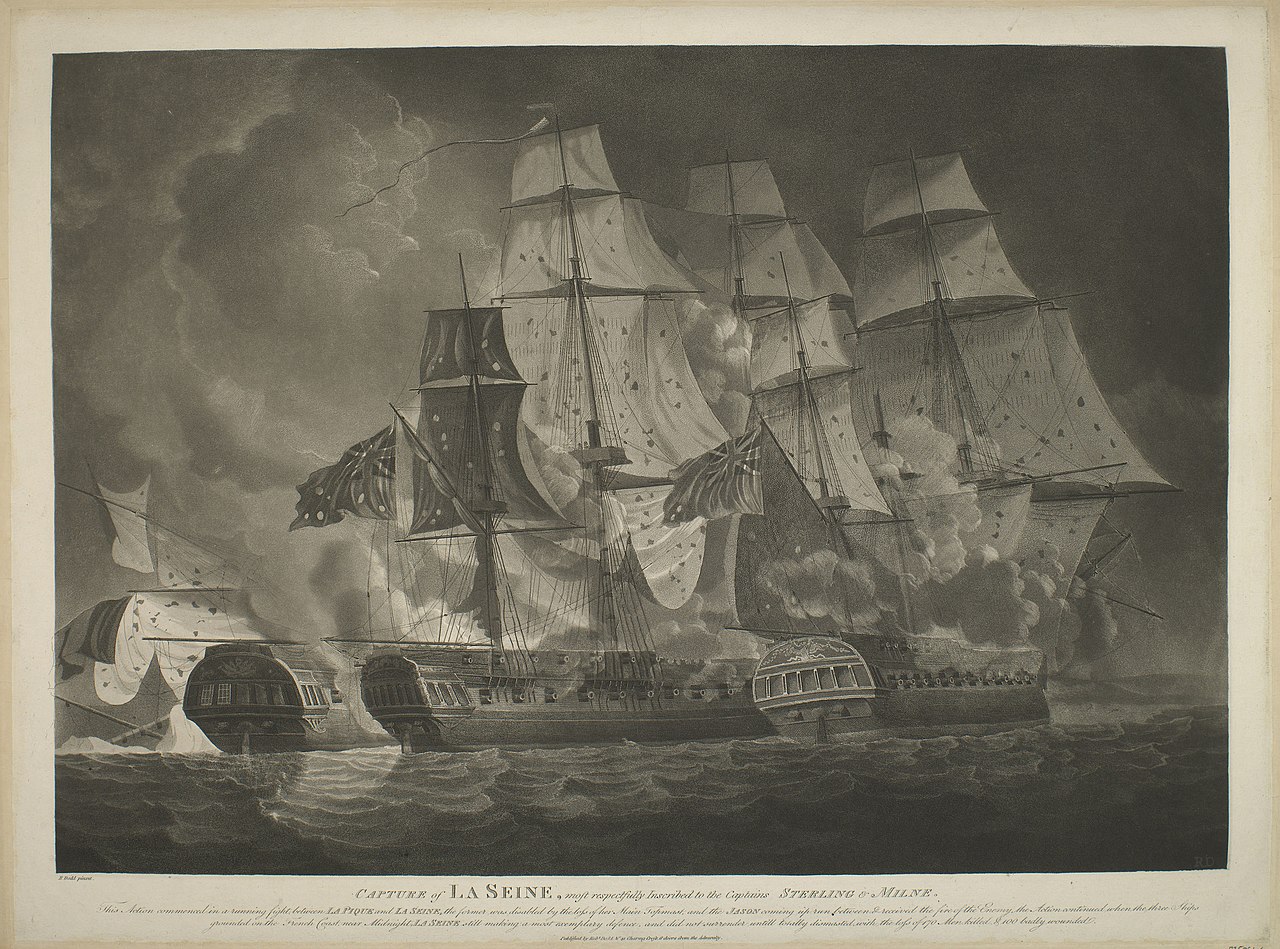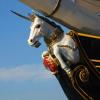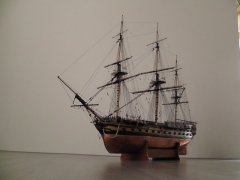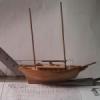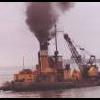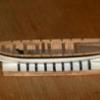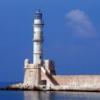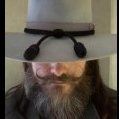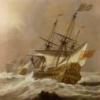-
Posts
2,245 -
Joined
-
Last visited
Reputation Activity
-
 Beef Wellington reacted to Hubac's Historian in Soleil Royal by Hubac's Historian - Heller - An Extensive Modification and Partial Scratch-Build
Beef Wellington reacted to Hubac's Historian in Soleil Royal by Hubac's Historian - Heller - An Extensive Modification and Partial Scratch-Build
So, some bit of progress. The lower hull is completely painted!
The most time-consuming aspect of this was getting good clean lines where the wales join the side planking. One of the peculiarities of the kit is that the wales are moulded with tremendous variation in their projection from the hull planking; around the bow, it’s almost 3/32”, but in other places, it’s a shy 1/32”.
The important thing is that the line be clean, and not bleed onto the planking. I have had little success with masking, so the best way was to cut it in by hand. When I did bleed, I would quickly wipe away the mistake with a dampened Q-tip. If I noticed other irregularities, in process, I would very gently scrape away at the still-soft acrylic until the mistake disappeared.
What was satisfying is that I found an application for all of the distressing mediums that I had bought to experiment with.
The Van Dyke Brown oil paint was, of course, the main distressing agent. I found that the starboard side - which I distressed after doing the port side - was darker in appearance, so I had to then go a little darker on the port side.
Rather than a full application of VDB, I applied small dabs with a Q-tip, in a sparse but well-distributed pattern, along the run of guns and between the wales. I then used my “dirty” chip brush to spread and blend the paint, evenly, across the surface. This was an easy solution to the problem, and quickly brought both sides into agreement.
The walnut ink was the perfect distress medium, over the ModelMaster Insignia Red of the gunport linings. It was very easy to dial back the effect with a slightly damp brush, if the accumulation was too heavy.
Lastly, I was able to muddy the spray-primed ultra-white waterline with two different Testors enamel stain washes; first, I brushed on a light layer of grey wash, and wiped off the excess with a Q-tip wrapped with a t-shirt scrap. I found that two applications of the grey - one after the other, with only a 5-minute set time in-between - gave me a satisfyingly lead-white color. To finish, though, I used a brown enamel wash, and only one coat was sufficient to give me the ring-around-the-ship effect of the vessel anchoring at what was likely a pretty polluted waterway, at Brest. This was one area where leaving the moulded kit grain was beneficial because the grain caught traces of the brown wash.
The very last thing was to seal everything under a spray-coat of clear matte medium, which homogenized the two different kinds of black acrylic that I used for the port and starboard sides.
So, now, I can begin laying out the mounting base and constructing the model - 🥳!!
-
 Beef Wellington got a reaction from Sjors in HMS Jason by Beef Wellington - Caldercraft - 1:64 - Artois-class frigate modified from HMS Diana 1794
Beef Wellington got a reaction from Sjors in HMS Jason by Beef Wellington - Caldercraft - 1:64 - Artois-class frigate modified from HMS Diana 1794
Many thanks all for the comments and likes, definitely good to have people along for the journey..
Feels like a chapter is coming to a close, finally seem to be closing in on completing the upper deck. Definitely a multitude of time consuming small tasks. First off I needed to address the fixed part of the gangway. This is shown quite clearly in plan view on page 46 of AOTS Diana, however it is not shown in profile. Given that it appears to contain its own lodging knee, I decided to extend the profile of the deck beam. This seems to make sense when recognizing that a ladder will eventually be located here. This highlights one of the inconsistencies in the AOTS book, many diagrams show the non-flush gangboards which I understand were going out of fashion at this point to be replaced by flush gangboards. Hoping I'm not too far off the mark here. A strip with a slight profile was added also to the deck beam to sit flush with the false quarterdeck.
The base plate to the stove was ripped off and replaced despite my intentions to leave as, hopefully this sits a little more harmoniously.
Cables have been added and "secured" to the various ring bolts beside the midship gratings. AOTS describes these as being used for stoppers, but decided to secure with simpler ring ropes as described in Lever. Stoppers have been modelled as per Lever on the 2 foremost ring bolts, but not yet tied on or attached permanently to allow me to finally decide (or others to refute) the approach taken.
Even though this area will only ever be glimpsed, time was spent fully building out the area around the foremast with the For jeer and for topsail sheet bitts as they would appear. The actual bitts on the fo'c'sl will be mounted to the deck, seemed unnecessarily complicated to build these fully. Couldn't quite figure out what was represented on diagrams for the fore jeer bitts until I saw interior photos of contemporary models in the Roger's Dockyard Model collection - but still no clue what the "swan neck" arrangement is called. What is very interesting is how crowded this forward area really is, fighting these guns must have been a real challenge.
Warning: Here follows some highly indulgent closeups taken on Captain's rounds! This is the closest I guess I'll get to seeing what this looked like in practice
And finally...some overall shots with where things stand..
-
 Beef Wellington got a reaction from cog in HMS Jason by Beef Wellington - Caldercraft - 1:64 - Artois-class frigate modified from HMS Diana 1794
Beef Wellington got a reaction from cog in HMS Jason by Beef Wellington - Caldercraft - 1:64 - Artois-class frigate modified from HMS Diana 1794
Gents, very much appreciate the information being shared. Could I please suggest that any further discussion on gun rigging and cannon firing techniques and procedures find their way into a specific post for that purpose, there are already quite a few of these already on the site and definitely better placed there to keep all content relevant and on topic. Of course more than happy to answer questions on the approach taken for this model.
-
 Beef Wellington reacted to chris watton in Chris Watton and Vanguard Models news and updates
Beef Wellington reacted to chris watton in Chris Watton and Vanguard Models news and updates
Hi Guys,
Thanks for the comments (I have just got back from work, (it is 1.07am).
Speedy is coming on just fine, I am working on the prototype model. Masts and spars turned, blocked up, stepped and shrouds and ratlines added. Hundreds of construction pictures taken, which I will need to assemble into a manual once the model is finished. I have to complete the model first as I then need to get the box art done and sent off to the printers. Printing the box lids can take a while, so getting the model finished, and then box art, and then instruction manual is the order of priority. When building and taking pics, I am away from the PC. When at Amati, others sorted out putting the manuals together, box art and sorting materials. I have to do it all, as I am the only one...
I have nothing to update when building the model, I have to spend a lot of time on it to make me look half decent for the pics, but rest assured, because I have been quiet on here doesn't mean I have been twiddling my thumbs. Also, I don't want to keep adding pics that look mostly the same, with one small part or a yard added, that would be boring. The next pics I put up will be of the completed, or very nearly completed model.
I think it may be a good idea to offer the pearwood strip for the second planking as the primary material, rather than Tanganyika for Speedy. No one wants the Alert with the cheaper wood, so I assume Speedy (which is more expensive anyway) will be the same. There will be three options though, pear or cherry at the same price, or a cheaper Tanganyika version. I am about to order the 4 and 3mm wide pearwood for Speedy.
Regarding Bristol, when I first started doing this, I really wanted Bristol as my second kit, and I do have some parts already made and cast for this model, plus I have drawn the bulkheads, keel and decks. However, a couple more smaller kits makes more economic sense, as Bristol is a big kit, and will take 6 months at least (full time). I want to start developing new kits full time as soon as possible. If I have three kits released and they sell well, I can give up my day job (safety net) and concentrate fully on Vanguard Models. A model like Bristol would prolong this - but the smaller models are taking 3-4 months each at the moment, even with my day job. But it is very long hours, hence the lack of updates on here. Saying that, I do not mind, as I chose to do this, I just wanted to try and explain what is going on right now.
Cheers,
Chris
(Ready for bed...)
-
 Beef Wellington reacted to DocBlake in HMS Blandford by DocBlake - FINISHED - 1/32 Scale - cross-section
Beef Wellington reacted to DocBlake in HMS Blandford by DocBlake - FINISHED - 1/32 Scale - cross-section
I've been working on some odds and ends. I finally decided I'd like to make the gun carriages out of boxwood. I liked the look of the boxwood carriages we used in the 17th Century Battle Station build. We used Mike's plans, and I had the carriages cut out of boxwood. Here they are, without the cannons. We have another idea for those!!!
-
 Beef Wellington reacted to mtaylor in HMS Blandford by DocBlake - FINISHED - 1/32 Scale - cross-section
Beef Wellington reacted to mtaylor in HMS Blandford by DocBlake - FINISHED - 1/32 Scale - cross-section
Nice save Dave. For copper, look into Liver of Sulfur as it doesn't affect the wood. EdT uses it in his models with great success. You brush it on, give it a bit and then wipe it off with a damp cloth.
-
 Beef Wellington reacted to DocBlake in HMS Blandford by DocBlake - FINISHED - 1/32 Scale - cross-section
Beef Wellington reacted to DocBlake in HMS Blandford by DocBlake - FINISHED - 1/32 Scale - cross-section
Hamilton: The idea was to keep the framing relatively simple, so a novice builder would be comfortable. I have no earthly idea why I chose copper for the bolts!
David: The Beech is really nice to work with!
After I realized my mistake in using copper for the keel scarf, I figured out a strange way to blacken the copper. Normally to simulate black bolts I would cut of the ends of toothpicks and let them sit in a bath of Solar-Lux Jet Black wood dye. The dye penetrates the full thickness of the toothpick so no white core. Just put the tip in some CA glue and push them into place. Clip and sand.
This is kind of crazy but let me explain what I did to "blacken" the copper bolts in the keel. I first tried "painting" the exposed copper with Jax Black and Brass Black. The black residue that formed bled into the surrounding wood and made a mess. I sanded back to bare wood and metal and tried again. I tried painting the copper flat black, but the results were not uniformly round, and the paint looked terrible. Sanded to bare wood and copper again. The I saw something on the internet!
Hard boil, cool and peel 2 eggs. Chop up the eggs and break up the shells and layer them on the bottom of a plastic container with a tight fitting top. Secure the keel to the top with bread bag ties so the part isn't sitting on the eggs. Wait over night. You can see the results in the photo. I did put a coat of poly over the blackening so that I don't damage it or rub it off somehow. The bolts still look like metal - but used and oxidized metal! It's the sulfur in the eggs!
-
 Beef Wellington reacted to chris watton in Chris Watton and Vanguard Models news and updates
Beef Wellington reacted to chris watton in Chris Watton and Vanguard Models news and updates
OK, Speedy hull now complete.
I did have to reduce the length of the chainplates for the 5mm deadeyes by 2mm, as they should only be pinned to the main wale, so the ones shown are a little too low - but rectified for the kit.
Hand pumps finally in place, nice easy builds with PE parts, and the stove chimney is PE this time, to give the correct scale appearance. Everything is now glued down apart from the boat, which is simply pinned in place at this time. Boomkins are missing, but they will be added once bowsprit gammoning is in place (experience...)
I have also included half a dozen hatchets, which were used primarily to cut fouled rigging away.
-
 Beef Wellington got a reaction from clearway in HMS Jason by Beef Wellington - Caldercraft - 1:64 - Artois-class frigate modified from HMS Diana 1794
Beef Wellington got a reaction from clearway in HMS Jason by Beef Wellington - Caldercraft - 1:64 - Artois-class frigate modified from HMS Diana 1794
Many thanks all for the comments and likes, definitely good to have people along for the journey..
Feels like a chapter is coming to a close, finally seem to be closing in on completing the upper deck. Definitely a multitude of time consuming small tasks. First off I needed to address the fixed part of the gangway. This is shown quite clearly in plan view on page 46 of AOTS Diana, however it is not shown in profile. Given that it appears to contain its own lodging knee, I decided to extend the profile of the deck beam. This seems to make sense when recognizing that a ladder will eventually be located here. This highlights one of the inconsistencies in the AOTS book, many diagrams show the non-flush gangboards which I understand were going out of fashion at this point to be replaced by flush gangboards. Hoping I'm not too far off the mark here. A strip with a slight profile was added also to the deck beam to sit flush with the false quarterdeck.
The base plate to the stove was ripped off and replaced despite my intentions to leave as, hopefully this sits a little more harmoniously.
Cables have been added and "secured" to the various ring bolts beside the midship gratings. AOTS describes these as being used for stoppers, but decided to secure with simpler ring ropes as described in Lever. Stoppers have been modelled as per Lever on the 2 foremost ring bolts, but not yet tied on or attached permanently to allow me to finally decide (or others to refute) the approach taken.
Even though this area will only ever be glimpsed, time was spent fully building out the area around the foremast with the For jeer and for topsail sheet bitts as they would appear. The actual bitts on the fo'c'sl will be mounted to the deck, seemed unnecessarily complicated to build these fully. Couldn't quite figure out what was represented on diagrams for the fore jeer bitts until I saw interior photos of contemporary models in the Roger's Dockyard Model collection - but still no clue what the "swan neck" arrangement is called. What is very interesting is how crowded this forward area really is, fighting these guns must have been a real challenge.
Warning: Here follows some highly indulgent closeups taken on Captain's rounds! This is the closest I guess I'll get to seeing what this looked like in practice
And finally...some overall shots with where things stand..
-
 Beef Wellington reacted to Vane in HMS Snake by Vane - Caldercraft - Scale 1:64
Beef Wellington reacted to Vane in HMS Snake by Vane - Caldercraft - Scale 1:64
Finally, inner walls done!
Now on to a very delicate part of the process which will really be visable once the kit is finished: finetuning the gun ports and adding wales.
So i better dont screw this up.
-
 Beef Wellington got a reaction from Old Collingwood in HMS Jason by Beef Wellington - Caldercraft - 1:64 - Artois-class frigate modified from HMS Diana 1794
Beef Wellington got a reaction from Old Collingwood in HMS Jason by Beef Wellington - Caldercraft - 1:64 - Artois-class frigate modified from HMS Diana 1794
Gents, very much appreciate the information being shared. Could I please suggest that any further discussion on gun rigging and cannon firing techniques and procedures find their way into a specific post for that purpose, there are already quite a few of these already on the site and definitely better placed there to keep all content relevant and on topic. Of course more than happy to answer questions on the approach taken for this model.
-
 Beef Wellington got a reaction from el cid in HMS Jason by Beef Wellington - Caldercraft - 1:64 - Artois-class frigate modified from HMS Diana 1794
Beef Wellington got a reaction from el cid in HMS Jason by Beef Wellington - Caldercraft - 1:64 - Artois-class frigate modified from HMS Diana 1794
Gents, very much appreciate the information being shared. Could I please suggest that any further discussion on gun rigging and cannon firing techniques and procedures find their way into a specific post for that purpose, there are already quite a few of these already on the site and definitely better placed there to keep all content relevant and on topic. Of course more than happy to answer questions on the approach taken for this model.
-
 Beef Wellington got a reaction from mtaylor in HMS Leopard by toms10 - FINISHED - 1:85 scale POF/POB
Beef Wellington got a reaction from mtaylor in HMS Leopard by toms10 - FINISHED - 1:85 scale POF/POB
From what I've seen, the edge would be rounded off, but to varying degrees. The more tapered at the top of the stem, the more rounded the profile. Nearer the keel the profile would be more square as it transitions to the width of the keel.
-
 Beef Wellington reacted to Kevin in Bluebell by Kevin - Revel - 1/72 - PLASTIC - Flower-class corvette with GLS upgrade - restarted Jan 2022
Beef Wellington reacted to Kevin in Bluebell by Kevin - Revel - 1/72 - PLASTIC - Flower-class corvette with GLS upgrade - restarted Jan 2022
Good evening everyone
whether it is right or wrong, yet again i find myself building the big bits, and yes even some of the kit is being used
Funnel and mast
the moulded banding is removed, as is the top spider the body is then covered from the PE set
these two units are made up from the box
more soldering
poor photo, was there to show the ladder against the funnel
4" gun
two shields are in the kit 1 suare the other curved, not know which im using yet so made them both
the bandstand went together better and anticipated
legs folded out
wooden spoon to shape the ring
edges tacked in numerous locations
i decided to solder this first before adding, it actually worked ok, there is a ridge the disc sits in, so once in place it was just tacked again
th
and the wheely bin again
-
 Beef Wellington got a reaction from KARAVOKIRIS in HMS Jason by Beef Wellington - Caldercraft - 1:64 - Artois-class frigate modified from HMS Diana 1794
Beef Wellington got a reaction from KARAVOKIRIS in HMS Jason by Beef Wellington - Caldercraft - 1:64 - Artois-class frigate modified from HMS Diana 1794
Many thanks all for the comments and likes, definitely good to have people along for the journey..
Feels like a chapter is coming to a close, finally seem to be closing in on completing the upper deck. Definitely a multitude of time consuming small tasks. First off I needed to address the fixed part of the gangway. This is shown quite clearly in plan view on page 46 of AOTS Diana, however it is not shown in profile. Given that it appears to contain its own lodging knee, I decided to extend the profile of the deck beam. This seems to make sense when recognizing that a ladder will eventually be located here. This highlights one of the inconsistencies in the AOTS book, many diagrams show the non-flush gangboards which I understand were going out of fashion at this point to be replaced by flush gangboards. Hoping I'm not too far off the mark here. A strip with a slight profile was added also to the deck beam to sit flush with the false quarterdeck.
The base plate to the stove was ripped off and replaced despite my intentions to leave as, hopefully this sits a little more harmoniously.
Cables have been added and "secured" to the various ring bolts beside the midship gratings. AOTS describes these as being used for stoppers, but decided to secure with simpler ring ropes as described in Lever. Stoppers have been modelled as per Lever on the 2 foremost ring bolts, but not yet tied on or attached permanently to allow me to finally decide (or others to refute) the approach taken.
Even though this area will only ever be glimpsed, time was spent fully building out the area around the foremast with the For jeer and for topsail sheet bitts as they would appear. The actual bitts on the fo'c'sl will be mounted to the deck, seemed unnecessarily complicated to build these fully. Couldn't quite figure out what was represented on diagrams for the fore jeer bitts until I saw interior photos of contemporary models in the Roger's Dockyard Model collection - but still no clue what the "swan neck" arrangement is called. What is very interesting is how crowded this forward area really is, fighting these guns must have been a real challenge.
Warning: Here follows some highly indulgent closeups taken on Captain's rounds! This is the closest I guess I'll get to seeing what this looked like in practice
And finally...some overall shots with where things stand..
-
 Beef Wellington got a reaction from jchbeiner in HMS Jason by Beef Wellington - Caldercraft - 1:64 - Artois-class frigate modified from HMS Diana 1794
Beef Wellington got a reaction from jchbeiner in HMS Jason by Beef Wellington - Caldercraft - 1:64 - Artois-class frigate modified from HMS Diana 1794
Vane - My preference is always to look to evidence where possible for inspiration. "The Sailing Frigate" by Robert Gardiner is an illustrated book charting the history of the frigate using contemporary models...I take no credit for anything!
The following images are from the National Maritime Museum collections site, but are illustrated in book mentioned.
Minerva (1780) showing the yellow ochre bulwarks with red spirketting
https://collections.rmg.co.uk/collections/objects/66278.html
Winchelsea (1772) showing the black coamings
https://collections.rmg.co.uk/collections/objects/66277.html
-
 Beef Wellington reacted to allanyed in HMS Leopard by toms10 - FINISHED - 1:85 scale POF/POB
Beef Wellington reacted to allanyed in HMS Leopard by toms10 - FINISHED - 1:85 scale POF/POB
Hi Tom
My apologies for jumping in so late in the game, but there is one thing that you may want to look at modifying. I only point this out as I made the same mistake on a model some years ago and was sorry I did not make the change. The knee of the head looks quite wide at the top forward portion. It should taper moving forward down to about 6 inches or so, where the figure head will sit. Where the pieces fit to the stem, they do widen as they rise as you show, but the top pieces should then taper a lot as they go forward. Maybe a difficult fix at this stage, but something to consider. As I had not made this change on my old model, the figure head looked bow legged. Again, my apologies for bringing this up now, I hope you don't mind. Allan
-
 Beef Wellington got a reaction from Old Collingwood in HMS Jason by Beef Wellington - Caldercraft - 1:64 - Artois-class frigate modified from HMS Diana 1794
Beef Wellington got a reaction from Old Collingwood in HMS Jason by Beef Wellington - Caldercraft - 1:64 - Artois-class frigate modified from HMS Diana 1794
Vane - My preference is always to look to evidence where possible for inspiration. "The Sailing Frigate" by Robert Gardiner is an illustrated book charting the history of the frigate using contemporary models...I take no credit for anything!
The following images are from the National Maritime Museum collections site, but are illustrated in book mentioned.
Minerva (1780) showing the yellow ochre bulwarks with red spirketting
https://collections.rmg.co.uk/collections/objects/66278.html
Winchelsea (1772) showing the black coamings
https://collections.rmg.co.uk/collections/objects/66277.html
-
 Beef Wellington got a reaction from JesseLee in HMS Jason by Beef Wellington - Caldercraft - 1:64 - Artois-class frigate modified from HMS Diana 1794
Beef Wellington got a reaction from JesseLee in HMS Jason by Beef Wellington - Caldercraft - 1:64 - Artois-class frigate modified from HMS Diana 1794
Vane - My preference is always to look to evidence where possible for inspiration. "The Sailing Frigate" by Robert Gardiner is an illustrated book charting the history of the frigate using contemporary models...I take no credit for anything!
The following images are from the National Maritime Museum collections site, but are illustrated in book mentioned.
Minerva (1780) showing the yellow ochre bulwarks with red spirketting
https://collections.rmg.co.uk/collections/objects/66278.html
Winchelsea (1772) showing the black coamings
https://collections.rmg.co.uk/collections/objects/66277.html
-
 Beef Wellington got a reaction from cog in HMS Jason by Beef Wellington - Caldercraft - 1:64 - Artois-class frigate modified from HMS Diana 1794
Beef Wellington got a reaction from cog in HMS Jason by Beef Wellington - Caldercraft - 1:64 - Artois-class frigate modified from HMS Diana 1794
Vane - My preference is always to look to evidence where possible for inspiration. "The Sailing Frigate" by Robert Gardiner is an illustrated book charting the history of the frigate using contemporary models...I take no credit for anything!
The following images are from the National Maritime Museum collections site, but are illustrated in book mentioned.
Minerva (1780) showing the yellow ochre bulwarks with red spirketting
https://collections.rmg.co.uk/collections/objects/66278.html
Winchelsea (1772) showing the black coamings
https://collections.rmg.co.uk/collections/objects/66277.html
-
 Beef Wellington got a reaction from Ronald-V in HMS Jason by Beef Wellington - Caldercraft - 1:64 - Artois-class frigate modified from HMS Diana 1794
Beef Wellington got a reaction from Ronald-V in HMS Jason by Beef Wellington - Caldercraft - 1:64 - Artois-class frigate modified from HMS Diana 1794
Many thanks all for the comments and likes, definitely good to have people along for the journey..
Feels like a chapter is coming to a close, finally seem to be closing in on completing the upper deck. Definitely a multitude of time consuming small tasks. First off I needed to address the fixed part of the gangway. This is shown quite clearly in plan view on page 46 of AOTS Diana, however it is not shown in profile. Given that it appears to contain its own lodging knee, I decided to extend the profile of the deck beam. This seems to make sense when recognizing that a ladder will eventually be located here. This highlights one of the inconsistencies in the AOTS book, many diagrams show the non-flush gangboards which I understand were going out of fashion at this point to be replaced by flush gangboards. Hoping I'm not too far off the mark here. A strip with a slight profile was added also to the deck beam to sit flush with the false quarterdeck.
The base plate to the stove was ripped off and replaced despite my intentions to leave as, hopefully this sits a little more harmoniously.
Cables have been added and "secured" to the various ring bolts beside the midship gratings. AOTS describes these as being used for stoppers, but decided to secure with simpler ring ropes as described in Lever. Stoppers have been modelled as per Lever on the 2 foremost ring bolts, but not yet tied on or attached permanently to allow me to finally decide (or others to refute) the approach taken.
Even though this area will only ever be glimpsed, time was spent fully building out the area around the foremast with the For jeer and for topsail sheet bitts as they would appear. The actual bitts on the fo'c'sl will be mounted to the deck, seemed unnecessarily complicated to build these fully. Couldn't quite figure out what was represented on diagrams for the fore jeer bitts until I saw interior photos of contemporary models in the Roger's Dockyard Model collection - but still no clue what the "swan neck" arrangement is called. What is very interesting is how crowded this forward area really is, fighting these guns must have been a real challenge.
Warning: Here follows some highly indulgent closeups taken on Captain's rounds! This is the closest I guess I'll get to seeing what this looked like in practice
And finally...some overall shots with where things stand..
-
 Beef Wellington got a reaction from Timmo in HMS Jason by Beef Wellington - Caldercraft - 1:64 - Artois-class frigate modified from HMS Diana 1794
Beef Wellington got a reaction from Timmo in HMS Jason by Beef Wellington - Caldercraft - 1:64 - Artois-class frigate modified from HMS Diana 1794
Many thanks all for the comments and likes, definitely good to have people along for the journey..
Feels like a chapter is coming to a close, finally seem to be closing in on completing the upper deck. Definitely a multitude of time consuming small tasks. First off I needed to address the fixed part of the gangway. This is shown quite clearly in plan view on page 46 of AOTS Diana, however it is not shown in profile. Given that it appears to contain its own lodging knee, I decided to extend the profile of the deck beam. This seems to make sense when recognizing that a ladder will eventually be located here. This highlights one of the inconsistencies in the AOTS book, many diagrams show the non-flush gangboards which I understand were going out of fashion at this point to be replaced by flush gangboards. Hoping I'm not too far off the mark here. A strip with a slight profile was added also to the deck beam to sit flush with the false quarterdeck.
The base plate to the stove was ripped off and replaced despite my intentions to leave as, hopefully this sits a little more harmoniously.
Cables have been added and "secured" to the various ring bolts beside the midship gratings. AOTS describes these as being used for stoppers, but decided to secure with simpler ring ropes as described in Lever. Stoppers have been modelled as per Lever on the 2 foremost ring bolts, but not yet tied on or attached permanently to allow me to finally decide (or others to refute) the approach taken.
Even though this area will only ever be glimpsed, time was spent fully building out the area around the foremast with the For jeer and for topsail sheet bitts as they would appear. The actual bitts on the fo'c'sl will be mounted to the deck, seemed unnecessarily complicated to build these fully. Couldn't quite figure out what was represented on diagrams for the fore jeer bitts until I saw interior photos of contemporary models in the Roger's Dockyard Model collection - but still no clue what the "swan neck" arrangement is called. What is very interesting is how crowded this forward area really is, fighting these guns must have been a real challenge.
Warning: Here follows some highly indulgent closeups taken on Captain's rounds! This is the closest I guess I'll get to seeing what this looked like in practice
And finally...some overall shots with where things stand..
-
 Beef Wellington got a reaction from Sjors in HMS Jason by Beef Wellington - Caldercraft - 1:64 - Artois-class frigate modified from HMS Diana 1794
Beef Wellington got a reaction from Sjors in HMS Jason by Beef Wellington - Caldercraft - 1:64 - Artois-class frigate modified from HMS Diana 1794
Thanks everyone, need to record a few things before moving on too much further:
Tackles:
Boy, these blighters take time. I will definitely not be fully rigging each gun, but will look to rig those fall into possibly the 'noticeable in the background' category. Here's the method I found works best for me. Apologies for the photos, an iPhone is really not the best at trying to photograph tiny objects suspended in the air.
A hook was threaded with 0.3mm Syren line and some overhand knots tied to seize this securely. Drop of GS Hypo cement to keep secure before trimming excess. The long ends are then placed around the block and loose overhand knot tied.
A length of line for the tackle fall is then inserted into the loop and then threaded back through itself as for a false splice.
Pulling the overhand know tight around the block, and simultaneously tightening the false splice secures the knot around the block. Another small drop of GS Hypo cement on the false splice helps keep this secure, and placing the end of the stropping line into 'helping hands' helps keep the knot tight while the cement dries.
Slightly weighting the tackle fall line (in this case with tweezers) allows the alignment if the block to be tweaked before the cement sets fully. Thin thread can then be seized around the splice to secure it, I find alternating overhand knots gives a pretty secure and easy result. Once more, another drop of GS Hypo on the seizing helps ensure this doesn't unravel once trimmed.
Once completed, I use some dilute PVA glue on the stropping prior to trimming off any excess as some additional insurance as it is a frustrating experience for these to break when frapping. The tackle falls were then fed through the previously stropped double blocks, and then frapped on the service machine as per a previous post. The last turn was secured simply by feeding back through the prior turn and pulling taught. The completed tackle can then be placed where needed and some dilute PVA applied again to the whole tackle - special attention was paid to ensuring the tackle fed through the frapping was secured with glue. The entire tackle can then be removed once dry and the excess line trimmed. Its a simple matter to hook these back into position. Et voila!
Stove:
The stove has also been given a little more TLC and is now glued into position. Handles for the boilers were added, as well as rails which were made from brass rod. The rails were the treated with some JAX 'Brown' to darken it a little a keep it in keeping with the colour of the copper still. As described in a previous post, I've followed TFFM simulating wooden battens under the custom base plate rather than simulating tiles, they would not been seen in any event once the main riding bitts are in place. Temporarily putting the fo'c'sl deck in place shows that much of this will be obscured even if the various gratings are made removeable which I plan to do.
In closing, a quick summary of the 3D printed stove. With a little work I'm happy with the way this turned out. Comparison to the kit supplied version shows the dimensions to be a little more authentic, and the detailing is much more pleasing than the approximations on the supplied white metal parts. To be fair, no work was done to pretty this up, but I'd certainly recommend this as a simple 'upgrade'.
-
 Beef Wellington got a reaction from Old Collingwood in HMS Jason by Beef Wellington - Caldercraft - 1:64 - Artois-class frigate modified from HMS Diana 1794
Beef Wellington got a reaction from Old Collingwood in HMS Jason by Beef Wellington - Caldercraft - 1:64 - Artois-class frigate modified from HMS Diana 1794
Cheers Mark, OC for kind words and the likes, appreciate the ongoing interest.
@Pat - he does sup while working 🙂
@Bob - Welcome aboard! My main source for this is The Fully Framed Model by David Anscherl (in this case Vol II, page 145), an excellent and very digestibly reference pulling together information only otherwise available in primary sources. As Phil points out above, line would be looped around the tackle blocks a couple of times first, and this is a slightly simplified representation, as pointed out, this can be seen on HMS Victory in practice. I think a lot of modelling decisions are based on aesthetics, and my personal preference is for a nice clear deck. Practically, guessing this would have kept the line off of an exposed deck which would likely have resulted in rot issues over extended periods of time.
@Phil - I appreciate the interest and kind words. The blocks are 1/8" single and double, and the paint used is Admiralty Red Ochre supplied by Caldercraft. The fine thread is UNI-Thread W 6/0 Tan - not sure what that means, but that's what's on the reel! Nothing fancy, think I picked it up at a local craft store some time ago, its synthetic so need to use GS-Hypo cement rather than PVA if it needs to be secured.
@Vane - I'm embarrassed to say it, photos are from an iPhone.... 🤐
-
 Beef Wellington got a reaction from mtaylor in What colour should the wheels the Canon be painted in?
Beef Wellington got a reaction from mtaylor in What colour should the wheels the Canon be painted in?
I'm not sure there is an absolutely correct answer to this question, I wondered myself many times, and I'm sure varied according to period, trends and fashions. I do enjoy looking at the many examples of contemporary models, but these typically do not tend to show model with cannon, but where they do they appear to be both red carriages and wheels in the 18 century/Royal Navy category. Who knows, this may also have been modelers whimsy, my own choice was to go with red wheels, but that was simply because I felt that anything else would have just looked too busy within the context of the model. Nice thing (or not so nice depending on your preference) is that leaving unpainted allows you to show some other details like the bolts in the wheels (Blue Ensign has a really good example of this in his wonderful Pegasus build)
There are 3 current physical examples on historical RN ships (Victory, Tricomalee and Unicorn), and the USS Constitution. I don't think any of these could be considered to be contemporaneous:
HMS Victory - yellow ochre carriages, wooden wheels
Trincomalee (slightly later period) - red carriages, black wheels
Frigate Unicorn - unpainted carriages and wheels, these are relatively recent additions to the ship to make it a more interesting visitor attraction and I'm not sure how much thought was put into period accuracy
USS Constitution - red (more salmon pink) carriages and black wheels - this is probably the least contemporaneous as the ship reflects her state after later rebuilds.

